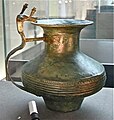Dürrnberg
History
The history of Dürrnberg and its territory is closely related to the presence of salt on its mountains. Previously used as an allocation for nomadic hunters around 2000/2500 years b.C., was used by Celtic tribes around 600 BC. For the important Celtic bronze flagon found there, now in the Keltenmuseum in Hallein, see Basse Yutz Flagons.
Geography
The village is located on a hillside upon Salzach river and under the Obersalzberg mountain range. It lies close to Austrian borders with Bavaria, Germany and nearest German village is Oberau, few km after the frontier. Dürrnberg is 4 km far from Hallein, 20 from Salzburg and 12 from the Bavarian town of Berchtesgaden.
Main sights
The Hallein Salt Mine, also known as Salzbergwerk Dürrnberg, is an underground salt mine located in the middle of the village. Opened for visitors in 1994, it hosts a museum and is receptive for tourism, as the other Austrian underground salt mines in Hallstatt and Altaussee.
Gallery
Celtic artefacts from Dürrnberg
-
Celtic village reconstruction
-
Celtic village reconstruction
-
Dürrnberg Celtic flagon
-
Celtic gold boat model
-
Celtic leather shoe, 5th century BC
See also
References
- ^ "Hallein Salt Mine website (salzwelten.at)". Archived from the original on 2009-08-13. Retrieved 2012-03-04.
- ^ "Brief history view of the salt mine in Dürrnberg". Archived from the original on 2011-04-27. Retrieved 2012-03-04.
External links
![]() Media related to Dürrnberg at Wikimedia Commons
Media related to Dürrnberg at Wikimedia Commons



















